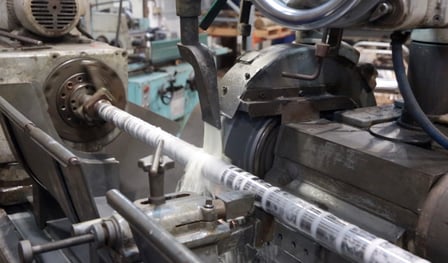The step by step of hard chrome plating process
Step 1: Inspection
In the initial inspection, the rod is assessed to evaluate its condition ahead of the chroming process. Here the inspector will note any evidence of corrosion, pitting, marring, damage, cracking or flaking of the material. Presence of these phenomena will be taken into account and may influence the decisions taken at various steps along the re-chroming process.
Step 2: Grinding & Stripping
Before new chrome can be applied, the old material must be removed. However, this must be done in such a way to preserve the steel underneath and without reducing the diameter of the rod itself. Doing so would result in a rod that exceeds cylinder tolerances. There are two methods for removing this material. These are: grinding and stripping.
Electrolytic Stripping:
During stripping, the rod is placed in a reverse-electrolysis tank. This process is essentially the opposite of electrolytic plating. Whereas chrome plating applies a positive current to a chrome solution - which adheres chrome molecules to the surface of the steel, reverse electrolysis does the opposite. A negative current is applied to the solution and chrome molecules separate from the surface - thereby stripping the old chrome away.
Stone Grinding:
The other method to remove old chrome is through grinding with large stone grinding wheels. The rod is centered on a large lathe-like grinding machine. The rod is rotated at a constant rate and brought into contact with the spinning stone grinding wheel. The friction wears away the old material much like sanding varnish from a piece of wood (except with more sparks). This technique requires a high level of skill and experience from the operator who must instinctively gauge how much pressure to apply to remove the layer of chrome without damaging the steel underneath. Experienced operators have such good feel for it, that they can determine the progress of removal simply by placing one fingertip against the spinning cylinder rod.

Step 3: Cleaning & Masking
Once the old chrome material has been removed, it is time to prepare the cylinder rod to be placed in the bath of chromium solution. Before this can happen, the rod must be thoroughly cleaned and any debris or contaminants must be removed. Failing to do this could result in undesirable anomalies during the plating process such as pitting and pinholes or flaking and peeling of the chrome during the life of the cylinder. At this stage, the rod is cleaned and the ends are masked to ensure a neat and professional final product.
Step 4: Plating
This is the part that most of us are familiar with. The process of electrolytic plating is a well-known one. It is used in everything from plating jewellery with gold to applying reflective metal plating to satellites and spacecraft. In this process, objects to be plated are placed in a bath containing a solution of dissolved metal molecules (in our case this metal is a special Chromium formulation). Electrodes are attached to the object to be plated and a positive current is applied to the solution. As the current runs through the solution and out through the electrodes, it causes the dissolved metal particles in the solution to be attracted to and adhere to the metal surface of the metal.
Step 5: Surface Finishing
With a fresh new layer of chrome applied, it’s time for the rods to be finished. This takes place in two stages in which the chrome coating is reduced to the exact, required thickness and then polished to achieve the perfect surface finish. These stages are post-grinding and linishing.
Step 6: Inspection
Before the chroming job is complete, it must pass the unforgiving gaze of the inspector. Armed with an experienced eye and digital surface thickness and roughness measurement devices, the rod is inspected for the quality of the chrome job, and to ensure there are no defects.
Step 7: Wrapping
As a final step in the process, the completed rod is wrapped securely in cardboard and protective plastic. This is done to safeguard the perfect chrome surface while it is transported back to the repair division.

Comments
Post a Comment